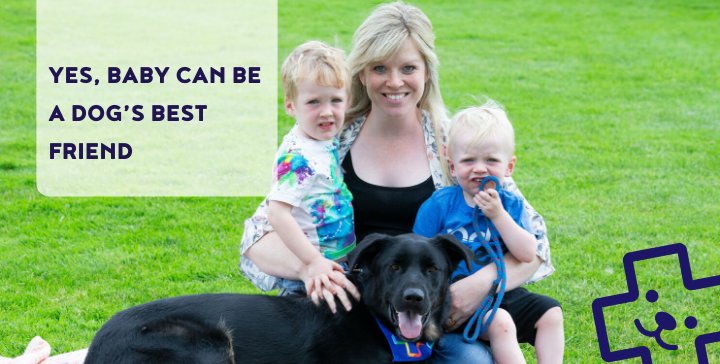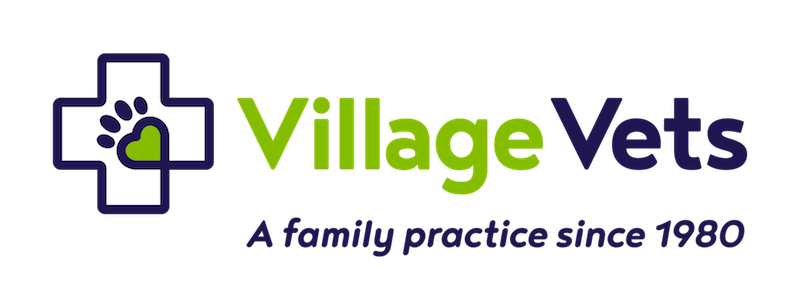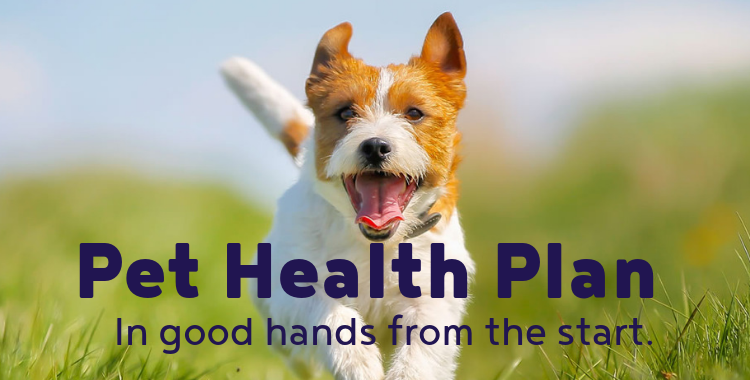
Introducing a new member into the family is a joyous occasion as a house becomes a home filled with the pitter-patter of tiny feet. But if you are introducing two legs to four paws, the experience can seem daunting and filled with what a re often unnecessary fears.
Stories of jealous dogs or cats attacking a baby brought into a home, where a much-loved pet of long standing has previously been the focus of all the attention, can sometimes prompt new parents into rehoming their dogs or cats – or even putting them into an animal shelter.

But except in the most extreme of cases, none of that is necessary says leading vet Aoife Caulfield who, with a new baby girl, two young boys, four dogs, a cat, horses and some pigs really should know And she says with a few strict rules, patience, and some good, old-fashioned house manners – it’s perfectly possible to make a home happy and harmonious for both children and pets, with both the richer for the experience.
Through her work as a vet with Village Vets, Aoife has seen that some people can feel overwhelmed at the prospect of mixing pooches with new babies. Some expectant parents have even got rid of their pets ahead of a new arrival. Some people, she says, may choose to give away a previously loved dog or cat to family members or simply leave them with an animal rescue.

But she is firm in her assertion that there is no reason to dump a dog for a new baby. Parents can fear a child may develop allergies or pick up diseases from handling a pet. But much of this is unfounded, says Aoife. ‘One of the things we do see a lot of is when children develop allergies, doctors are very quick to blame it on dogs. In general, there is acres of research that shows that exposure to dogs in infancy is protective, it’s protective against allergies and it’s good for your immune system. ‘It does give children a sense of responsibility from early on. The sense of empathy is very important, learning to be kind to other creatures.’
Aoife, who lives in Meath with her husband Kieron Duignan and their two young boys Barney, three, and one-year-old Hector also shares her home with four dogs, a cat, horses and some pigs.
At the time of our interview, she is just weeks away from giving birth to her third child, baby April, and has already laid the groundwork for the arrival with her pets.

‘We have four dogs, a cat, four horses, and we rear pigs,’ she says. ‘I’ve always loved animals, I had a cat growing up at home but my parents didn’t like dogs so I started out riding horses when I was younger. As soon as I was in my final year in college I had my own dog. I brought her to Canada with me and since then I have been accumulating and now we have a menagerie,’ she says with a laugh. Along with her farmer husband, they are happy to open their doors to one and all, saying they ‘accommodate anyone who wants to come and live with us here now.’
But having so many feet of both the two and four-legged variety running about can sometimes lead to a chaotic situation. However, says Aoife, with some basic manners and house rules, chaos can be averted.
‘Having done it a few times now, there are some basics. The important thing is that you have good basic manners on your dog, or cat, in the first place. When they are in the house everyone needs boundaries and rules. What you need to have is dogs who follow instructions, so they are not just running riot and are all over the place; that they have a degree of obedience."
‘The most important thing for me is that the dogs have their own bed that they can get into where they have their own safe space, and that they have consistency. So at any time if I need my dogs to give space if I tell them to go into their bed, they go there, and they stay there.
‘If you need to feed the baby or change nappies you just need them to sit quietly for a few minutes, you can say “into bed”, and you can have certainty that is where they will go and that’s where they will stay. That’s the number one the task to teach them, it gives you a little bit of comfort.’
Aoife says preparation is key before the arrival of a new baby so nobody’s nose is out of joint.

‘There are plenty of things that you can do to introduce them. You can get them used to walking with the buggy. It can be tricky going for a walk with an empty buggy but you can go with the dog and buggy around the garden so when you do get back out walking again after your baby arrives, you can still go for a walk. It’s best not to tie them to it, have the leash in one hand and good brakes on the buggy, because if they see something and run they can pull it over. It’s happened to me,’ she recalls wryly. ‘But get them used to walking alongside a buggy and not pulling. Again it’s about having those basic manners before the baby comes.’ Indoors is no different."
‘Have areas that they can and cannot go. So if they are used to coming upstairs with you they are not allowed in the baby’s room if you have the door open – you don’t want the dog to disturb the baby or climb into the cot. Have areas that are allowed and areas that are off-limits. Introduce them to some of the baby stuff in advance, whether it’s furniture or clothes smells. Especially with a first baby, there is going to be a lot of new stuff and smells, so get them used to that kind of stuff before the baby comes home. That will happen naturally if you gradually introduce the stuff.’
Once home, Aoife says it is important to allow the dog to meet the new baby because it can’t be just a thing where it is a mystery. ‘What you need to do here is you come into the house first and get over the excitement. You have been away in the hospital for a few days, the dog hasn’t seen you, so they are really excited to see you.
"What you don’t want to do is introduce the baby in the middle of all that excitement and they associate the baby with that excitement.
‘You need to get everybody calm, even if it’s just for a couple of minutes. Leave himself outside with the baby, you come in and meet the dogs, let them all get settled and then bring the baby in.
‘Only when everyone is calm introduce them to the dogs. Let them have a sniff at a distance but it’s best if they have a sniff and they get bored and walk away, that’s what you want, that they go “OK this is new, but it isn’t a threat,” that it isn’t something to get excited about or is scary.
‘You just want it to be something that’s there that doesn’t evoke an emotion for the dog. Once you achieve that, then the baby is here and that’s just part of life.’
Aoife also has some stern words, based on her clinical training and personal experience, for parents who may have a fear that a rambunctious or jealous dog may bite or attack a child.
‘When children are bitten by dogs it is the owner’s fault. If you own a dog or when you take a dog, the responsibility you take is that you know that dog, their limits and what they are capable of. If you put them in a situation where they have the need to bite, that’s the owner’s fault. It is extremely rare that it’s the dog’s fault, we have put them in that position.
‘The rules – well, in my house anyway – are if the dog chooses to get into bed that’s their safe space, so the dog isn’t allowed to be touched while they’re in their own bed. They must be left alone.
‘Children can’t be allowed to climb on them, pull ears, to pull tails, to stick fingers in places and mouths. It’s our jobs to make sure these little people aren’t manhandling the dogs – every dog will have a different limit.
‘You have to train your children to be respectful. But ultimately it is your responsibility not to put your dogs in a position where they could injure the children"
TOP TIPS FOR A HAPPY HOME WITH BABIES AND PETS
- Ensure that the dog has their own bed, blanket or crate where they can be told to go for their own space. Try to get your dog used to walking with a buggy or pram.
- Do not tie the leash to the buggy, however, as the dog may try to run and pull it over. Establish areas in which your dog can and cannot go.
- If they are allowed to go upstairs, ensure the dog knows they are not allowed into a baby’s room. Introduce them to some of the baby paraphernalia in advance of the new arrival.
- Let them sniff and examine baby's furniture and clothes.
- Never allow a child to antagonise a dog, or pull its tail or ears.
- When you bring a baby home for the first time, greet the dogs yourself without the baby. Let them welcome you and wait until everyone is calm and settled before introducing them to the baby.
Written by Niamh Walsh





